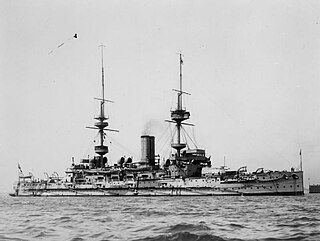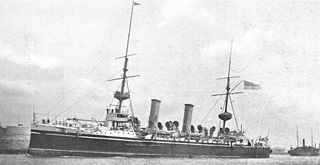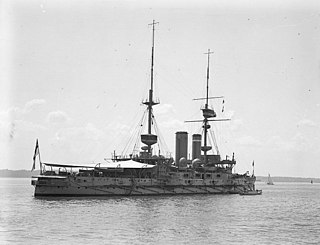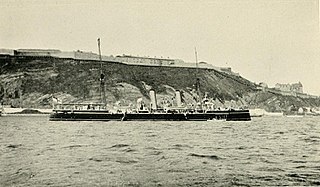
The third HMS Illustrious of the British Royal Navy was a Majestic-class pre-dreadnought battleship. The ship was built at the Chatham Dockyard; her keel was laid down in March 1895, her completed hull was launched in September 1896, and she was commissioned into the fleet in April 1898. She was armed with a main battery of four 12-inch (305 mm) guns and a secondary battery of twelve 6-inch (152 mm) guns. The ship had a top speed of 16 knots.

HMS Australia was one of seven Orlando-class armoured cruisers built for the Royal Navy in the mid-1880s. She was assigned to the Mediterranean Fleet in 1889 and remained there until 1893 when she returned home. The ship was assigned to the Coast Guard Squadron for the next decade before she was placed in reserve in 1903. Australia was sold for scrap in 1905.

HMS Minerva was an Eclipse-class protected cruiser built for the Royal Navy in the mid-1890s.

HMS Hawke, launched in 1891, was the seventh British warship to be named Hawke. She was an Edgar-class protected cruiser.

HMS Implacable was a Formidable-class battleship of the British Royal Navy, the second ship of the name. The Formidable-class ships were developments of earlier British battleships, featuring the same battery of four 12-inch (305 mm) guns—albeit more powerful 40-calibre versions—and top speed of 19 knots of the preceding Canopus class, while adopting heavier armour protection. The ship was laid down in July 1898, was launched in March 1899, and was completed in July 1901. Commissioned in September 1901, she was assigned to the Mediterranean Fleet and served with the fleet until 1908. After a refit, she transferred to the Channel Fleet, then onto the Atlantic Fleet in May 1909. By now rendered obsolete by the emergence of the dreadnought class ships, she was assigned to the 5th Battle Squadron and attached to the Home Fleet in 1912.

HMS Resolution was a Royal Sovereign-class pre-dreadnought battleship of the Royal Navy. The ship was built by Palmers Shipbuilding and Iron Company, starting with her keel laying in June 1890. She was launched in May 1892 and, after completing trials, was commissioned into the Channel Squadron the following December. She was armed with a main battery of four 13.5-inch guns and a secondary battery of ten 6-inch guns. The ship had a top speed of 16.5 knots.

HMS Pelorus was the first of the Pelorus-class cruiser, and was laid down at Sheerness dockyard in 1896. Completed and commissioned into the Royal Navy on 15 December the same year, she was designed by Sir William White. Construction cost £154,315. The ship was well armed for her size, but was primarily a workhorse for the overseas fleet.

HMS Doris was an Eclipse-class protected cruiser built for the Royal Navy in the mid-1890s.

HMS Hannibal was a Majestic-class pre-dreadnought battleship built for the Royal Navy, and the sixth ship to bear the name HMS Hannibal. The ship was laid down at the Pembroke Dock in May 1894, she was launched in April 1896, and commissioned into the fleet in April 1898. She was armed with a main battery of four 12-inch (305 mm) guns and a secondary battery of twelve 6-inch (152 mm) guns. The ship had a top speed of 16 knots.

HMS Crescent was a first class cruiser of the Edgar class in the British Royal Navy. Crescent, and her sister ship Royal Arthur, were built to a slightly modified design and are sometimes considered a separate class. She was launched in 1892, saw early service at the Australia Station and the North America and West Indies Station, served in the First World War, and was sold for breaking up in 1921.

HMS Sutlej was a Cressy-class armoured cruiser built for the Royal Navy around 1900. Upon completion she was assigned to the China Station. In 1906 she became a training ship for the North America and West Indies Station before returning home and being assigned as the flagship of the reserve Third Fleet in 1909. Relieved as flagship in 1910, she remained in reserve until the beginning of World War I in August 1914.

HMS Andromeda was one of eight Diadem-class protected cruisers built for the Royal Navy in the 1890s. Upon completion in 1899, the ship was assigned to the Mediterranean Fleet where she helped to escort a royal yacht during its cruise through the Mediterranean Sea. After a refit, she was assigned to the China Station in 1904 and returned home three years later to be reduced to reserve. Andromeda was converted into a training ship in 1913 and remained in that role under various names until 1956. That year she was sold for scrap and broken up in Belgium, the last Pembroke-built ship still afloat.

HMS Royal Sovereign was the lead ship of the seven ships in her class of pre-dreadnought battleships built for the Royal Navy in the 1890s. The ship was commissioned in 1892 and served as the flagship of the Channel Fleet for the next five years. She was transferred to the Mediterranean Fleet in 1897 and returned home in 1902, and was briefly assigned as a coast guard ship before she began a lengthy refit in 1903–1904. Royal Sovereign was reduced to reserve in 1905 and was taken out of service in 1909. The ship was sold for scrap four years later and subsequently broken up in Italy.

HMS Glory was a pre-dreadnought battleship of the British Royal Navy and a member of the Canopus class. Intended for service in Asia, Glory and her sister ships were smaller and faster than the preceding Majestic-class battleships, but retained the same battery of four 12-inch (305 mm) guns. She also carried thinner armour, but incorporated new Krupp steel, which was more effective than the Harvey armour used in the Majestics. Glory was laid down in December 1896, launched in March 1899, and commissioned into the fleet in November 1900.

HMS Pyramus was a Pelorus-class protected cruiser of the Royal Navy. There were eleven ""Third class"" protected cruisers in the class, which was designed by Sir William White. While well armed for their size, they were primarily workhorses for the overseas fleet on "police" duties and did not serve with the main battlefleet.

HMS Pandora was a Pelorus-class cruiser of the Royal Navy. There were eleven "Third class" protected cruisers in the class, which was designed by Sir William White. While well armed for their size, they were primarily workhorses for the overseas fleet on "police" duties and did not serve with the main battlefleet.

HMS Pomone was a Pelorus-class protected cruiser built for the Royal Navy in the late 1890s. The ship's boilers were so troublesome that she was decommissioned in 1904 after only a single foreign deployment. She was hulked in 1910 and served as a stationary training ship until 1922 when she was sold for scrap.

HMS Prometheus was a Pelorus-class protected cruiser of the Royal Navy. Ten sister third class protected cruisers were built — designed by Sir William White. While well-armed for their size, they were primarily workhorses for the overseas fleet considered to be on police duties. She was sold for scrap in 1914.

HMS Proserpine was a Pelorus-class cruiser of the Royal Navy. There were eleven "Third class" protected cruisers in the class, which was designed by Sir William White. While well armed for their size, they were primarily workhorses for the overseas fleet on "police" duties and did not serve with the main battlefleet.

HMS Isis was an Eclipse-class protected cruiser built for the Royal Navy in the mid-1890s.




















